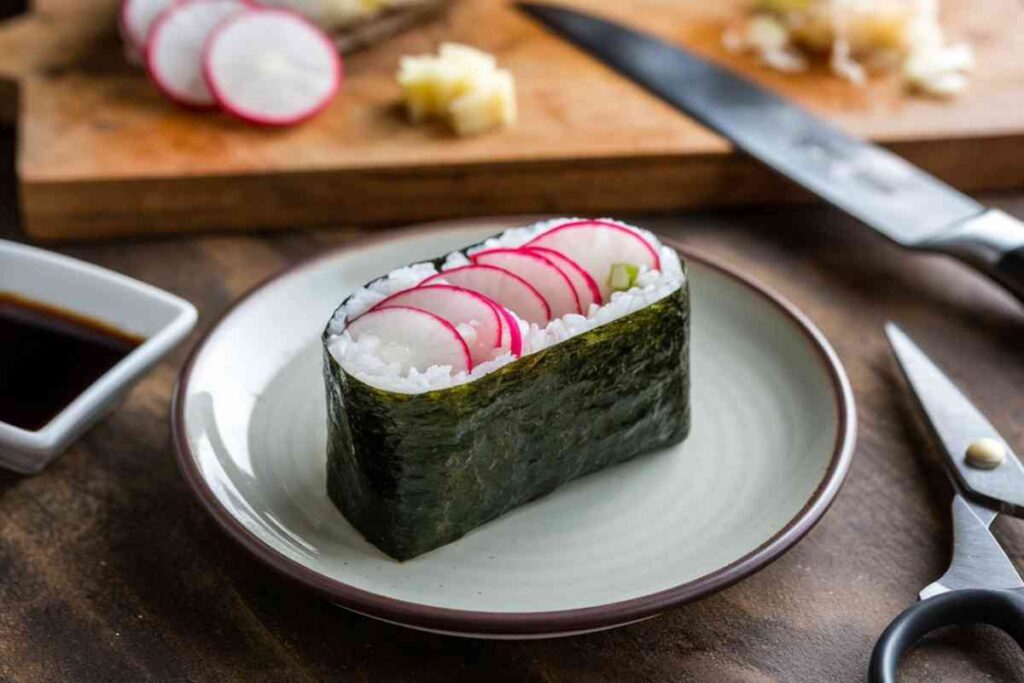- What is Sushi Radish?
- Sushi Radish Benefits
- How to Make Sushi Radish: A Step-by-Step Recipe
- Creative Uses for Sushi Radish
- Health Benefits of Daikon Radish Sushi
- Expert Tips for Perfect Sushi Radish
- Conclusion
- FAQs
- What is the best type of radish for sushi?
- How do I make pickled radish for sushi?
- Can I use other types of radish in sushi?
- What are the health benefits of sushi radish?
- How do I get a crisp texture in sushi radish?
- How long does pickled radish for sushi last?
- Can I use sushi radish in other dishes?
- Is sushi radish suitable for vegetarian diets?
Sushi radish, often referred to as daikon, is a staple in Japanese cuisine that adds both flavor and texture to a variety of dishes, particularly sushi.
Whether you’re looking to elevate your homemade sushi or explore new culinary techniques, understanding sushi radish is essential.
This comprehensive guide will explore everything from its health benefits to how you can incorporate it into your favorite sushi recipes.
What is Sushi Radish?

Sushi radish, most commonly daikon, is a white, mild-flavored radish used widely in Japanese cooking.
It has a slightly peppery taste, a crunchy texture, and can be eaten raw, pickled, or cooked.
Daikon radish is particularly popular in sushi radish recipes, where it’s used in radish sushi rolls and as a garnish for sushi and sashimi.
Types of Sushi Radish
Daikon Radish:
A mild, versatile radish that is a go-to choice for many Japanese radish sushi dishes.
Pickled Radish (Takuan):
A sweet, tangy pickled radish often used in pickled radish for sushi, providing a unique balance to savory ingredients.
Sushi Radish Benefits
Including sushi-radish in your dishes does more than enhance flavor. It offers a range of health benefits that contribute to a well-balanced diet.
Rich in Nutrients
Sushi-radish is packed with Vitamin C, potassium, and antioxidants, making it a nutritious addition to your meal.
Low in Calories
Daikon and other types of white radish sushi are low in calories, which makes them perfect for anyone watching their caloric intake while enjoying sushi.
Aids Digestion
The high fiber content in sushi-radish promotes good digestion, helping prevent constipation and maintain regular bowel movements.
Detoxifying Properties
Radishes, especially daikon, are known for their liver-detoxifying properties, which help eliminate toxins from the body.
High Water Content
The high water content of sushi-radish keeps you hydrated, making it an excellent addition to sushi or salads during warmer months.
How to Make Sushi Radish: A Step-by-Step Recipe
Looking to incorporate radish into your sushi? Follow this easy sushi-radish recipe to enjoy fresh, homemade radish sushi rolls.
Ingredients for Sushi Radish Rolls
- 1 large daikon radish
- 250g sushi rice
- 2 tablespoons rice vinegar
- 1 tablespoon sugar
- 1 pinch of salt
- 2 sheets of nori (seaweed)
- 1 avocado, sliced
- Pickled radish (optional)
- Soy sauce for dipping
- Pickled ginger (for serving)
Step 1: Prepare the Sushi Rice
- Rinse the sushi rice under cold water until the water runs clear.
- Cook the rice according to package instructions, usually simmering for 10 minutes.
- Once cooked, mix in rice vinegar, sugar, and salt. Allow the rice to cool.
Step 2: Slice the Daikon Radish
- Peel the daikon radish and slice it into thin strips.
- Soak the radish in ice water for 5-10 minutes to enhance its crispness.
Step 3: Assemble the Sushi Rolls
- Place a sheet of nori on a sushi mat or a clean towel.
- Spread a thin layer of the prepared rice over the nori, leaving an inch at the top.
- Add sliced radish and avocado down the center.
- Roll the sushi tightly, sealing the nori with a bit of water.
Step 4: Slice and Serve
- Slice the sushi roll into bite-sized pieces using a sharp knife.
- Serve with soy sauce, pickled ginger, and wasabi on the side.
Creative Uses for Sushi Radish

Beyond traditional radish sushi rolls, sushi-radish can be used in many different ways to enhance a variety of dishes.
Sashimi Garnish
Thinly sliced daikon radish is often used as a garnish for sashimi, providing a crunchy texture alongside delicate fish slices.
Pickled Radish
Pickled radish for sushi, also known as takuan, is a sweet and tangy side that pairs beautifully with sushi rolls.
Radish Salad
Incorporate thinly sliced radish into a light salad, adding sesame oil or soy dressing for a refreshing side dish.
Noodle Topping
Use julienned daikon as a topping for noodle dishes like ramen or soba, adding crunch and flavor to your meal.
Health Benefits of Daikon Radish Sushi
Daikon radish is a nutritional powerhouse and offers numerous health advantages when used in Japanese radish sushi or other dishes.
Supports Weight Loss
Due to its low calorie content, daikon is an excellent ingredient for those looking to lose or manage weight.
Anti-inflammatory Properties
The antioxidants in daikon help reduce inflammation, potentially protecting against various chronic diseases.
Improves Skin Health
By promoting detoxification, daikon can contribute to clearer skin and overall better health.
Respiratory Health
Daikon radish can help reduce mucus production and improve breathing, making it a natural remedy for colds and congestion.
Expert Tips for Perfect Sushi Radish

Choose Fresh Radish
Always select firm, unblemished radishes for the best texture and flavor.
Use a Sharp Knife
To achieve thin, uniform slices for your sushi, a sharp knife or mandoline slicer is essential.
Soak in Ice Water
Soaking radish in ice water after slicing ensures maximum crispness for your sushi rolls.
Conclusion
Sushi radish is a simple yet impactful ingredient that elevates sushi rolls and other dishes.
Whether you use it fresh, pickled, or as a garnish, sushi radish offers a delightful balance of flavor and texture.
Its health benefits and versatility make it a must-have in any kitchen, whether you’re a seasoned chef or a sushi-making novice.
So, start incorporating sushi radish into your meals and enjoy both its culinary and nutritional benefits!
FAQs
What is the best type of radish for sushi?
The best radish for sushi is daikon, a white, mild-flavored radish that complements sushi rolls and sashimi.
How do I make pickled radish for sushi?
Pickle daikon radish by marinating thin slices in rice vinegar, sugar, and salt for at least 30 minutes. The result is a tangy, slightly sweet flavor.
Can I use other types of radish in sushi?
Yes, while daikon is traditional, you can experiment with red or watermelon radishes for a sharper, more colorful twist on your sushi rolls.
What are the health benefits of sushi radish?
Sushi-radish is rich in Vitamin C, low in calories, and high in fiber, making it a nutritious addition to your diet. It also promotes digestion and detoxification.
How do I get a crisp texture in sushi radish?
For a crisp texture, slice the radish thinly and soak it in ice water for 5-10 minutes before using it in sushi rolls or as a garnish.
How long does pickled radish for sushi last?
Pickled radish can be stored in the refrigerator for up to three days in an airtight container.
Can I use sushi radish in other dishes?
Yes! Sushi-radish is versatile and can be used in salads, as a sashimi garnish, or as a crunchy topping for noodle dishes.
Is sushi radish suitable for vegetarian diets?
Yes, sushi-radish is plant-based and suitable for both vegetarian and vegan diets.




